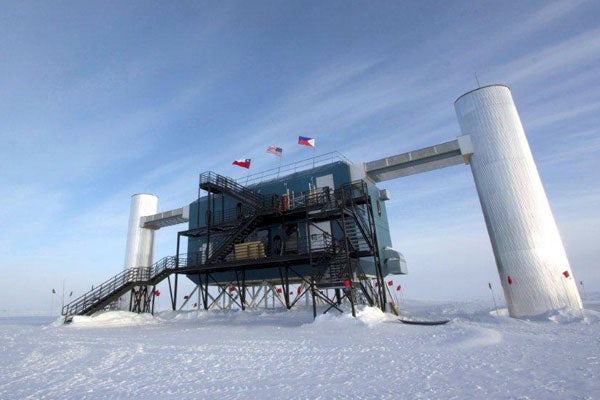
Antarctic project IceCube named Breakthrough of the Year by Physics World
Published: December 13, 2013
International high-energy physics research project IceCube has been named the 2013 Breakthrough of the Year by British magazine Physics World.
The Antarctic observatory has been selected for making the first observation of cosmic neutrinos, but also for overcoming the many challenges of creating and operating a colossal detector deep under the ice at the South Pole.
“The ability to detect cosmic neutrinos is a remarkable achievement that gives astronomers a completely new way of studying the cosmos,” said Hamish Johnston, editor of physicsworld.com. “The judges of the 2013 award were also impressed with the IceCube collaboration’s ability to build and operate a huge and extremely sensitive detector in the most remote and inhospitable place on Earth.”
Essentially a telescope in the ground, the IceCube Neutrino Observatory was completed in December 2010, after seven years of construction at the South Pole. But the idea of a huge detector buried in the ice was conceived a long time ago and in the 1990s, the AMANDA detector was built as a proof of concept for IceCube. By January 2005, the first sensors of IceCube had already reached 2,450 metres below the Antarctic ice sheet, and a few weeks ago the IceCube Collaboration published the first evidence for a very high-energy astrophysical neutrino flux in Science.
“This is the beginning of a new era for astronomy,” said University of Toronto physicist and IceCube collaborator Ken Clark. “This result opens up the ability to use neutrinos to explore our universe. These really are the ideal messenger particles since they can travel vast distances without stopping or slowing.”
IceCube principal investigator is Francis Halzen, the Hilldale and Gregory Breit Professor of Physics at the University of Wisconsin-Madison. As he envisioned, the Antarctic ice became the perfect medium to search for very high-energy neutrinos that, after travelling through the universe during millions — even billions — of years, haphazardly interact with the nucleus of a molecule of ice.
“I did not imagine that the science would be as exciting as building this detector,” said Halzen. “Challenges were many, from deciphering the optical properties of ice that we have never seen, to drilling a hole to 2.5 kilometres in two days, and then repeating 86 times. The success of IceCube builds on the efforts of hundreds of collaborators around the world — from the design, the deployment in a harsh environment and the AMANDA prototype, to data harvesting and physics analysis.”
IceCube is composed of 5,160 digital optical modules suspended along 86 cables embedded in a cubic kilometre of ice beneath the South Pole. It detects neutrinos through the tiny flashes of blue light, called Cherenkov light, that are produced when neutrinos interact in the ice. The photo below shows an IceCube string being lowered below the ice (photo by IceCube/NSF). The deployment of each of the 86 IceCube strings lasted about 11 hours. In each one, 60 sensors (called DOMs) had to be quickly installed before the ice completely froze around them.
Physics World will be hosting a Google Hangout on Friday, December 13, at 11a.m. EST with:
- Hamish Johnston, editor of physicsworld.com (in London)
- Francis Halzen, University of Wisconsin-Madison professor and principal investigator of IceCube (in Madison, Wisconsin)
- James Roth, a member of the IceCube Collaboration and a senior electronics instrument specialist at the University of Delaware (at the Amundsen-Scott South Pole Station)
The Hangout can also be viewed live on the Physics World YouTube channel.
The IceCube Neutrino Observatory was built under a National Science Foundation Major Research Equipment and Facilities Construction grant, with assistance from partner funding agencies around the world. The project continues with support from a Maintenance and Operations grant from the NSF’s Division of Polar Programs and Physics Division, along with international support from participating institutions and their funding agencies. UW–Madison is the lead institution and the international collaboration includes 275 physicists and engineers from the U.S., Germany, Sweden, Belgium, Switzerland, Japan, Canada, New Zealand, Australia, U.K., Korea and Denmark.
(Video: Deployment of the last DOMCredit: IceCube/NSF The last Digital Optical Module in the IceCube array descends into the ice just before 6pm on the 18th of December, 2010 South Pole time.The world's largest neutrino detector was complete!)
Sean Bettam is a writer with the Faculty of Arts & Science at the University of Toronto.



